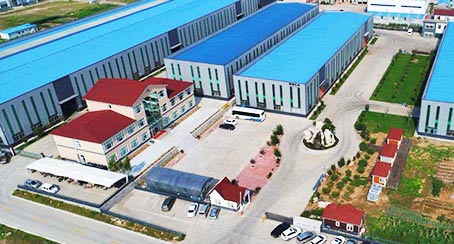Hot-dip galvanizing design process of hot-dip galvanizing
- Categories:Industry News
- Author:
- Origin:
- Time of issue:2020-07-08 14:53
- Views:
(Summary description)The formation process of the hot-dip galvanized layer is the process of forming an iron-zinc alloy between the iron matrix and the outermost pure zinc layer.
Hot-dip galvanizing design process of hot-dip galvanizing
(Summary description)The formation process of the hot-dip galvanized layer is the process of forming an iron-zinc alloy between the iron matrix and the outermost pure zinc layer.
- Categories:Industry News
- Author:
- Origin:
- Time of issue:2020-07-08 14:53
- Views:
The formation process of the hot-dip galvanized layer is the process of forming an iron-zinc alloy between the iron matrix and the outermost pure zinc layer. The iron-zinc alloy layer is formed on the surface of the workpiece during hot-dip coating, which makes the iron and pure zinc layer very close. Good combination, the process can be simply described as: when the iron workpiece is immersed in molten zinc, a solid solution of zinc and α iron (body core) is first formed on the interface. This is a crystal formed by dissolving zinc atoms in the base metal iron in a solid state. The two metal atoms are fused, and the attraction between the atoms is relatively small. Therefore, when zinc reaches saturation in the solid solution, the two element atoms of zinc and iron diffuse each other, and the zinc atoms that have diffused (or infiltrated) into the iron matrix migrate in the matrix lattice, and gradually form alloys with iron and diffuse The iron and zinc in the molten zinc form an intermetallic compound FeZn13, which sinks into the bottom of the hot-dip galvanizing pot, which is called zinc dross. When the workpiece is removed from the zinc immersion solution, a pure zinc layer is formed on the surface, which is a hexagonal crystal. Its iron content is not more than 0.003%.
Hot-dip galvanized layer protection performance
The thickness of the electro-galvanized layer is usually 5-15μm, and the hot-dip galvanized layer is generally above 65μm, even as high as 100μm. Hot-dip galvanizing has good coverage, dense coating and no organic inclusions. As we all know, the mechanism of zinc resistance to atmospheric corrosion includes mechanical protection and electrochemical protection. Under atmospheric corrosion conditions, there are protective films of ZnO, Zn(OH)2 and basic zinc carbonate on the surface of the zinc layer, which can slow down the corrosion of zinc to a certain extent. The layer protective film (also called white rust) is damaged and a new layer is formed. When the zinc layer is seriously damaged and the iron matrix is endangered, zinc will produce electrochemical protection to the matrix. The standard potential of zinc is -0.76V, and the standard potential of iron is -0.44V. When zinc and iron form a microbattery, zinc is dissolved as an anode. Protected as a cathode. Obviously, hot-dip galvanizing has better atmospheric corrosion resistance to base metal iron than electro-galvanizing.
Formation control of zinc ash and slag during hot-dip galvanizing
Zinc ash and zinc slag not only seriously affect the quality of the zinc dipping layer, but also cause the coating to be rough and produce zinc nodules. Moreover, the cost of hot-dip galvanizing is greatly increased. Usually, the zinc consumption is 80-120kg per 1t workpiece. If the zinc ash and dross are serious, the zinc consumption will be as high as 140-200kg. Controlling the zinc carbon is mainly to control the temperature and reduce the scum produced by the oxidation of the zinc liquid surface. Some domestic manufacturers use refractory sand, charcoal ash, etc. Foreign countries use ceramic or glass balls that have low thermal conductivity, high melting point, low specific gravity, and do not react with zinc liquid, which can reduce heat loss and prevent oxidation. This kind of ball is easy to be pushed away by the workpiece and has no adhesion to the workpiece. Side effect.
For the formation of zinc dross in zinc liquid, it is mainly a zinc-iron alloy with extremely poor fluidity formed when the iron content dissolved in the zinc liquid exceeds the solubility at this temperature. The zinc content in the zinc dross can be as high as 95%, which is hot-dip galvanizing. The key to the high cost of zinc.
From the solubility curve of iron in zinc liquid, it can be seen that the amount of dissolved iron, that is, the amount of iron loss, is different at different temperatures and different holding times. At around 500℃, the iron loss increases sharply with heating and holding time, almost in a linear relationship. Below or above the range of 480~510℃, the iron loss increases slowly with time. Therefore, people call 480~510℃ the malignant dissolution zone. In this temperature range, the zinc solution will corrode the workpiece and the zinc pot the most severely. The iron loss will increase significantly when the temperature is above 560℃. If the temperature is above 660℃, the zinc will destructively etch the iron matrix. The zinc dross will increase sharply and the plating will not be possible. . Therefore, plating is currently carried out in the two regions of 450-480°C and 520-560°C.
Scan the QR code to read on your phone
Weifang Jingxiang Electromechanical Equipment Co., Ltd.
About

Weifang Jingxiang Electromechanical Equipment Co., Ltd. is a domestic large-scale color steel plate production line, color aluminum plate production line
Contact
Messages
Code


